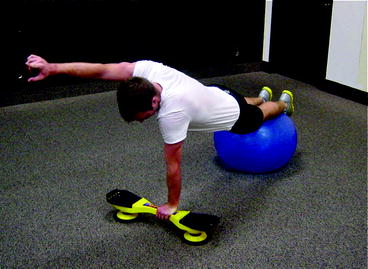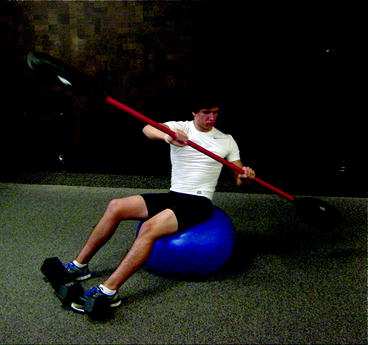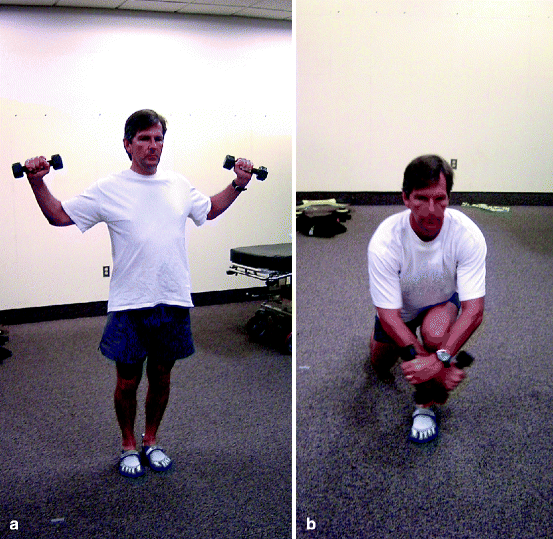Fig. 16.1
Lateral plank with hip abduction, front plank, “C”-roll progression to develop endurant upper and lower extremity strength integrating the trunk and core regions
Injury Prevention Must Equal Performance Enhancement
In designing an injury prevention plan, the extreme sports athlete should remember that any appropriately designed strategy also represents a performance enhancement plan. Establishing this simple link in the athlete’s mind may be the ultimate key to program compliance. As the plan is developed, the extreme sports athlete should be committed to the fact that for any conditioning step that is undertaken, there should be a sound rationale. The extreme sports athlete is advised to have a better understanding of their own intrinsic strengths (S) and weaknesses (W) in addition to the opportunities (O) for improvement available to them and potential threats (T) to safely returning from a sports outing. This type of S-W-O-T analysis as is commonly performed in business is a good idea, particularly if more skilled peers are encouraged to provide their perceptions regarding an extreme sports athlete’s capabilities.
What are the physiological requirements of the extreme sport [19]? What factors unique to the selected extreme sport have the greatest influence on physiological energy system (short-term or long-term anaerobic or aerobic) regulation and nutrition or hydration requirements? For the selected extreme sport, where, what, and when are injuries or system failures most likely to occur? For example, forward falling when mountain biking on a steep downhill run may increase in likelihood when decision-making is compromised either due to central fatigue or the thrill associated with excessive speed [20–22]. The ocean kayaker is generally more likely to drown if they decide to swim toward shore after capsizing rather than staying with their boat [23]. For sports with a high fall risk, it is essential that the extreme sports athlete understand the scenarios where falls are most likely to occur, the likely circumstances, biomechanical alignment, and pathomechanics associated with the fall, and how to effectively dissipate the energy associated with the fall into a safe rollout rather than relying on an outstretched arm or leg or failing to tuck the head-neck and upper back [24]. Do the fall risks involve potential high-speed one leg landings, forward or side rolling, or do they involve slow-speed balance loss events? On what surface are they likely to occur? What is the fall prevention strategy? Incorporating fall training, similar to judo and wrestling, into extreme sports training is essential. With purposeful practice, safe falling techniques become more second nature, reflexive, and subconsciously driven [25, 26]. Therefore, the extreme sports athlete will be more likely to automatically perform an appropriate reaction when the potentially injurious situation arises. As with neuromuscular training programs designed to prevent knee injury, the extreme sports athlete needs to eventually direct performance program focus more toward honing neuromuscular responsiveness to sudden, unexpected perturbations during injury mechanism simulations that are safe, yet somewhat similar to potentially injurious events [8].
Periodization in Training
Just as periodized training (preparatory phase, competitive event phase, and transition phase) contributes to improved performance among track-and-field athletes and weight lifters, similar principles can be applied to extreme sports preparation [27]. Early preparatory periods of strength-power development can be gradually and strategically translated into sport-specific functional need capabilities over the course of a year. Although early preparatory periods focus primarily on improving “raw” strength, power, endurance, and joint flexibility-tissue extensibility capabilities, during the later part of the preparatory phase, as the extreme sports athlete nears the time for their event, they should focus almost exclusively on refined movements involving coordinated trunk-core and upper-lower extremity function in a manner that simulates extreme sports performance (Fig. 16.2) [28]. During the later part of the preparatory phase, there is a strong overlay of neuromuscular responsiveness training given possible extreme sports scenarios where injury would be most likely to occur. These scenarios are not always limited to intrinsic extreme sports athlete or equipment issues, but also should consider extrinsic environmental factors such as low oxygen levels, limited freshwater supplies, extreme temperature or humidity conditions, wind, conditions that reduce vision (such as glare or fog), and conditions that reduce hearing. Additionally, the surface and surface-foot or surface-hand interface [29, 30] possibilities that are likely to be associated with an extreme sports injury warrant particular attention. Concerns related to this may affect both energy expenditure and safety. Performance training should incorporate possible injury scenarios and appropriate contingency strategies into the plan. The classic phrase “for want of a nail, all was lost,” may be analogous to lack of proper contingency planning. Lack of simple preparation such as how to adequately protect the skin on the hand, foot, face, or bony prominences of the pelvic region may have dire consequences [31].


Fig. 16.2
Forward walk out using Woggler™ (Elrey Enterprises, Inc., Corydon, IN) and stability ball performing a one arm reach at terminal position. An excellent way to train coordinated upper extremity and trunk-core region endurant strength
In addition to use of a periodization conditioning model to prepare for their extreme sport, athletes are advised to include adequate, rehydration, and nutrition [32] between work-out sessions to enhance system recovery tissue remodeling, and avoid overtraining. These days do not necessarily have to consist of complete rest but should include active rest working on perceived weak points such as balance [33, 34] via Tai Chi training or more dynamic perturbation response training, stretching, and cognitive mental planning practice through “chalk talks” (if-then scenarios) and other event planning strategies. Addressing perceived (and peer-validated performance) weaknesses enables the extreme sports athlete to both improve their injury prevention readiness and allow for connective tissue healing, remodeling, and strengthening through the application of the specific adaptations to imposed demands principle of training. As with many other sports that are loved by their participants, overtraining is a problem with extreme sports athletes, and insufficient tissue healing recovery periods can compromise future performance and safety. A significant difference with the extreme sports athlete however is that overtraining combined with underpractice, underplanning, poor skill development or inaccurate skill appraisal in combination with the instantaneous thrill of the event, and added stressors such as central fatigue are more likely to result in serious injury or death.
Self- and Skilled Peer Assessments
In addition to physiological system preparation and development of a conditioning training log that provides a record of their preparation, the extreme sports athlete is advised to similarly improve their capacity for honest contemplation or reflection, self-assessment of their risk-taking tendencies, how the “thrill factor” of their extreme sport may override sound decision-making, and overall appraisal of their personal skill level. Just as soccer, basketball, and football athletes tend to overrate their perceived return to play readiness following reconstructive knee surgery, we believe that many extreme sports athletes also tend to overrate their true skill level and underrate their risk-taking behavior. Men are generally more likely to overrate their skill levels than women [35]. Young and novice males are the most likely group to inaccurately assess their skill level and take greater risks. These extreme sports athletes are reminded to learn the old axiom: “There are old cowboys and there are bold cowboys, but there are no old, bold cowboys.” Acquiring an objective skill appraisal from a peer or higher skilled extreme sports athlete may be especially important to decrease the injury risk among this group of extreme sports athlete.
Specific Adaptations to Imposed Demands
Specificity of training (perfect preparation prevents poor performance) refers to having a comprehensive understanding of physiological and psychological extreme sports demands, the primary movements involved with differing performance techniques, the equipment-athlete interface, their influence on joints and muscle group recruitment, neuromuscular activation characteristics (concentric, isometric, eccentric), the velocity of joint movements, and potential pathomechanics that are most likely to result in acute-sudden injuries such as a poorly controlled single-leg landing or fall during skiing [36], or more chronic, overuse-type injuries such as the potential influence of distance kayak paddling on rotator cuff muscle health. For both injury prevention and extreme sports performance, the athlete should focus on developing efficient trunk-core neuromuscular integration for force-momentum transfer to the upper and lower extremities and endurant low back strength with neutral lumbopelvic alignment (avoiding excessive lordosis or kyphosis) (Fig. 16.3). The extreme sports athlete should determine if they possess inherently loose or hyperelastic joint connective tissues that enable excessive range of motions (particularly at the hands, wrists, elbows, hips, knees, and ankles) [37]. They may need to adjust their training to focus more on improving dynamic joint stability and midrange neuromuscular strength and control while being cognizant of maintaining the athletic position (slight hip, knee, and ankle flexion) during weightbearing to avoid breaking down capsuloligamentous joint “bumpers or excessive joint range restrictors” from repetitious conditioning practices and potentially overused dependence on postures that rely predominantly on noncontractile tissues. Although seemingly paradoxical, the extreme sports athlete with intrinsically hyper-lax joint connective tissues at the knee, for example, may also need to increase musculotendinous extensibility throughout the back and lower extremities, particularly at biarticular muscles (such as the hamstrings, rectus femoris, gastrocnemius, biceps brachii) or any other muscle with pelvic attachments to enable functionally safe positions to be assumed and maintained during extreme sports like rock or mountain climbing, kayaking, and distance running. Although it is essential for the extreme sports athlete to check, verify, familiarize, and practice with the equipment of their sport (including both primary and secondary technique and/or equipment adjustments), greater focus should be placed on the human decision-making side of the equation. As Paul McCartney wrote in the song Hey Jude, “…The movement you need is on your shoulders.”


Fig. 16.3
Alternating upper-lower extremity raise from a quadruped position. Cup with tennis or agility balls is placed on low back to encourage smooth movements and neutral lumbopelvic alignment
Example 1: Kayaker
Extreme sports whitewater kayaking places intense demands on the glenohumeral joints and rotator cuff muscles as the kayaker executes sudden turns, quick acceleration or deceleration, and rolls [38]. As with anyone who repetitively reaches or throws overhead, the glenohumeral joint and rotator cuff muscle group health of the extreme sport kayaker is directly influenced by scapulothoracic and lumbopelvic alignment, active mobility, coordination, and endurant strength-power. In addition to the repetitive demands placed on the upper extremities through repetitive paddling over long distances or the sudden bursts of maneuvering, the extreme sports kayaker needs to consider the accumulative effects of portaging, overhead carrying, or dragging their boats, as well as the likelihood of falling on an outstretched upper or lower extremity. Each of these mechanisms may further contribute to glenohumeral joint and rotator cuff muscle group injury. Foundational to any injury prevention-performance enhancement program but particularly important to the shoulder complex (glenohumeral joint and scapulothoracic articulation) is achieving and maintaining complete pain-free active range of motion in positions of function [39]. A position of function refers to evaluating and stretching the muscle or muscle group of interest into the length at which it must function during extreme sports performance, including slight exaggeration during training. Since during paddling and boat maneuvering the shoulder complex functions from a long-sitting position, it is essential to evaluate and train the system from this position (Fig. 16.4). Since portaging the boat likely involves use of the shoulder complex in a standing position, it is likewise essential also to evaluate and train the system from this position (Fig. 16.5a, b). In the first scenario, the kinetic chain functions from a base on the ischial tuberosities of the pelvis [40] with the lower extremities attempting to provide additional stabilization by bracing within the boat. In the second scenario, the kinetic chain functions from one or both lower extremities during weightbearing, transferring forces and momentum proximally through the lumbopelvic region and trunk to the upper extremities. As with one who repetitively performs overhead reaching or throwing, the rotator cuff of the glenohumeral joint is vulnerable to impingement through the loss of balanced function anywhere along the entire kinetic chain resulting in superior humeral head migration at the glenoid process of the scapula impinging the rotator cuff muscle group. Additionally, boat maneuvering may also place the whitewater kayaker at risk for glenohumeral joint instability associated with activity-related neuromuscular strength imbalances from repetitive shoulder extension-internal rotation, tending to inhibit and weaken rotator cuff muscle function. This loss of intrinsic rotator cuff muscle function in combination with the range of motion demands of paddling can combine to increase the likelihood of increasing capsulolabral laxity at the glenohumeral joints and dysfunction at the rotator cuff and scapulothoracic muscle groups [39, 41].


Fig. 16.4
Long-sitting paddling simulation on a stability ball with feet braced by dumbbells










